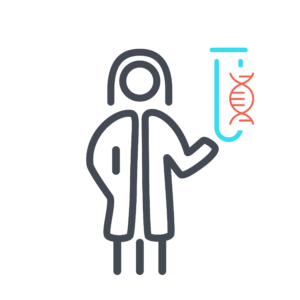SON-Related Syndrome

Table of contents
- What is SON-related syndrome?
- Key Role
- Symptoms
- What causes SON-related syndrome?
- Why does my child have a change in the SON-related syndrome gene?
- What are the chances that other family members of future children will have SON-related syndrome?
- How many people have SON-related syndrome?
- Do people who have SON-related syndrome look different?
- How is SON-related syndrome treated?
- Behavior and development concerns linked to SON-related syndrome
- Medical and physical concerns linked to SON-related syndrome
- Where can I find support and resources?
- Sources and References
SON-related syndrome is also called ZTTK syndrome. For this webpage, we will be using the name SON-related syndrome to encompass the wide range of variants observed in the people identified.
What is SON-related syndrome?
SON-related syndrome happens when there are changes in the SON gene. These changes can keep the gene from working as it should.

Key Role
The SON gene helps to control different processes inside the cell.
Symptoms
Because the SON gene is important for brain activity, many people who have SON-related syndrome have:
- Intellectual disability or developmental delay
- Changes in the structure of the brain
- Vision issues
- Seizures
- Changes in the muscles and skeleton
- Regression
- Lower than average muscle tone, also called hypotonia
- Feeding difficulties
- Short height
What causes SON-related syndrome?
SON-related syndrome is a genetic condition, which means that it is caused by variants in genes. Our genes contain the instructions, or code, that tell our cells how to grow, develop, and work. Every child gets two copies of the SON gene: one copy from their mother’s egg, and one copy from their father’s sperm. In most cases, parents pass on exact copies of the gene to their child. But the process of creating the egg or sperm is not perfect. A change in the genetic code can lead to physical issues, developmental issues, or both.
Sometimes a spontaneous variant happens in the sperm, egg or after fertilization. When a brand new genetic variant happens in the genetic code is called a ‘de novo’ genetic variant. The child is usually the first in the family to have the genetic variant.
De novo variants can take place in any gene. We all have some de novo variants, most of which don’t affect our health. But because SON plays a key role in development, de novo variants in this gene can have a meaningful effect.
Research shows that SON-related syndrome is often the result of a de novo variant in SON. Many parents who have had their genes tested do not have the SON genetic variant found in their child who has the syndrome. In some cases, SON-related syndrome happens because the genetic variant was passed down from a parent.
Autosomal dominant conditions
SON-related syndrome is an autosomal dominant genetic condition. This means that when a person has the one damaging variant in SON they will likely have symptoms of SON-related syndrome. For someone with an autosomal dominant genetic syndrome, every time they have a child there is a 50 percent chance they pass on the same genetic variant and a 50 percent chance they do not pass on the same genetic variant.
Autosomal Dominant Genetic Syndrome
Why does my child have a change in the SON-related syndrome gene?
No parent causes their child’s SON-related syndrome. We know this because no parent has any control over the gene changes that they do or do not pass on to their children. Please keep in mind that nothing a parent does before or during the pregnancy causes this to happen. The gene change takes place on its own and cannot be foreseen or stopped.
What are the chances that other family members of future children will have SON-related syndrome?
Each family is different. A geneticist or genetic counselor can give you advice on the chance that this will happen again in your family.
The risk of having another child who has SON-related syndrome depends on the genes of both biological parents.
- If neither biological parent has the same genetic variant found in their child, the chance of having another child who has the syndrome is on average 1 percent. This 1 percent chance is higher than the chance of the general population. The increase in risk is due to the very unlikely chance that more of the mother’s egg cells or the father’s sperm cells carry the same genetic variant.
- If one biological parent has the same genetic variant found in their child, the chance of having another child who has the syndrome is 50 percent.
For a symptom-free brother or sister of someone who has SON-related syndrome, the sibling’s risk of having a child who has SON-related syndrome depends on the sibling’s genes and their parents’ genes.
- If neither parent has the same genetic variant causing SON-related syndrome, the symptom-free sibling has a nearly 0 percent chance of having a child who would inherit SON-related syndrome.
- If one biological parent has the same genetic variant causing SON-related syndrome, the symptom-free sibling has a 50 percent chance of also having the same genetic variant. If the symptom-free sibling has the same genetic variant, their chance of having a child who has the genetic variant is 50 percent.
For a person who has SON-related syndrome, the risk of having a child who has the syndrome is about 50 percent.

How many people have SON-related syndrome?
As of 2024, at least 138 people with SON-related syndrome have been identified in a medical clinic.

Do people who have SON-related syndrome look different?
People who have SON-related syndrome may look different. Appearance can vary and can include some but not all of these features:
- Facial asymmetry, meaning one half of the face is not the mirror image of the other
- Low-set ears
- Deep-set eyes
- Horizontal eyebrows
- Wide nasal bridge

How is SON-related syndrome treated?
Scientists and doctors have only just begun to study SON-related syndrome. At this point, there are no medicines designed to treat the syndrome. A genetic diagnosis can help people decide on the best way to track the condition and manage therapies. Doctors can refer people to specialists for:
- Physical exams and brain studies
- Genetics consults
- Development and behavior studies
- Other issues, as needed
A developmental pediatrician, neurologist, or psychologist can follow progress over time and can help:
- Suggest the right therapies. This can include physical, occupational, speech, or behavioral therapy.
- Guide individualized education plans (IEPs).
Specialists advise that therapies for SON-related syndrome should begin as early as possible, ideally before a child begins school.
If seizures happen, consult a neurologist. There are many types of seizures, and not all types are easy to spot. To learn more, you can refer to resources such as the Epilepsy Foundation’s website: epilepsy.com/learn/types-seizures.

This section includes a summary of information from major published articles. It highlights how many people have different symptoms. To learn more about the articles, see the Sources and References section of this guide.
Behavior and development concerns linked to SON-related syndrome
Speech and learning
People with SON-related syndrome had developmental delay or intellectual disabilities, ranging from mild to severe, and speech delays.
- 79 out of 79 people had developmental delay or intellectual disability (100 percent)
- 29 out of 29 people had speech delays (100 percent)
The severity of intellectual disability (ID) varied among people:
- 10 out of 48 people had mild ID (21 percent)
- 14 out of 48 people had moderate ID (29 percent)
- 24 out of 48 people had severe ID (50 percent)

Behavior
More than one-half of people with SON-related syndrome had behavioral issues, such as sleep disturbances and autism.
- 27 out of 48 people had behavioral issues (56 percent)
- 12 out of 48 people had sleep disturbances (25 percent)
- 6 out of 48 people had autism (13 percent)
Brain
People with SON-related syndrome had lower than average muscle tone (hypotonia), seizures, and brain changes seen on magnetic resonance imaging (MRI). Common brain findings were ventriculomegaly, cortical dysplasia, and defects of the corpus callosum, the cerebral white matter, and the cerebellum.
- 33 out of 51 people had hypotonia (65 percent)
- 24 out of 52 people had seizures (46 percent)
- 41 out of 45 people had brain changes seen on MRI (91 percent)

Medical and physical concerns linked to SON-related syndrome
Feeding and digestion issues
The majority of people with SON-related syndrome had gastrointestinal defects, such as feeding difficulties and structural findings in the intestines, stomach, and gallbladder.
- 36 out of 51 people had gastrointestinal defects (71 percent)
- 30 out of 48 people had feeding difficulties (63 percent)
- 10 out of 45 people had structural findings (22 percent)
Heart
About 1 in 3 people with SON-related syndrome had heart defects, such as a hole in the heart, also called atrial or ventricular septal defects.
- 16 out of 51 people had heart defects (31 percent)
Other medical features
Some people with SON-related syndrome had vision issues, changes in the shape of the kidneys, and defects of the skin, hair, or nails.

Where can I find support and resources?
ZTTK SON-Shine Foundation
The ZTTK SON-Shine Foundation is committed to improving the lives of individuals with ZTTK by accelerating research to develop accessible and effective treatments and, ultimately, a cure. They focus on funding cutting-edge science, building strong support systems for the global ZTTK community, and raising awareness about ZTTK syndrome.
Simons Searchlight
Simons Searchlight is an online international research program, building an ever growing natural history database, biorepository, and resource network of over 175 rare genetic neurodevelopmental disorders. By joining their community and sharing your experiences, you contribute to a growing database used by scientists worldwide to advance the understanding of your genetic condition. Through online surveys and optional blood sample collection, they gather valuable information to improve lives and drive scientific progress. Families like yours are the key to making meaningful progress. To register for Simons Searchlight, go to the Simons Searchlight website at www.simonssearchlight.org and click “Join Us.”
- Learn more about Simons Searchlight: www.simonssearchlight.org/frequently-asked-questions
- Simons Searchlight webpage with more information on SON: www.simonssearchlight.org/research/what-we-study/son
- Simons Searchlight SON Facebook community: https://www.facebook.com/groups/son

Sources and References
The content in this guide comes from published studies about SON-related syndrome.
- Dingemans, A. J. M., Truijen, K. M. G., Kim, J. H., Alaçam, Z., Faivre, L., Collins, K. M., Gerkes, E. H., van Haelst, M., van de Laar, I., … & Vissers, L. (2022). Establishing the phenotypic spectrum of ZTTK syndrome by analysis of 52 individuals with variants in SON. European Journal of Human Genetics, 30(3), 271-281. https://pubmed.ncbi.nlm.nih.gov/34521999/
- Eid, M., & Bhatia, S. (2022). Novel de novo heterozygous variants in the SON gene causing ZTTK syndrome: A case report of two patients and review of neurological findings. Child Neurology Open, 9, 2329048X221119658. https://pubmed.ncbi.nlm.nih.gov/36387043/
- Pietrobattista, A., Della Volpe, L., Francalanci, P., Figà Talamanca, L., Monti, L., Lepri, F. R., Basso, M. S., Liccardo, D., Della Corte, C., … & Maggiore, G. (2023). The expanding phenotype of ZTTK syndrome due to the heterozygous variant of SON gene focusing on liver involvement: Patient report and literature review. Genes (Basel), 14(3). 739. https://pubmed.ncbi.nlm.nih.gov/36981010/
- Tang, S., You, J., Liu, L., Ouyang, H., Jiang, N., Duan, J., Li, C., Luo, Y., Zhang, W., … & Zhao, H. (2023). Expanding the mutational spectrum of ZTTK syndrome: A de novo variant with global developmental delay and malnutrition in a Chinese patient. Molecular Genetics & Genomic Medicine, 11(8), e2188. https://pubmed.ncbi.nlm.nih.gov/37488749/
